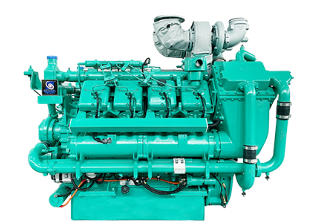- HOME
- ABOUT GOOGOL
- PRODUCTS
DIESEL ENGINE
GENERATOR SETS
- DOWNLOAD
- CASES
- NEWS
- CONTACT US
DIESEL ENGINE
GENERATOR SETS

The fuel injection system of electronic fuel injection diesel engines mainly achieves efficient fuel injection through a series of complex and precise processes.
Firstly, multiple sensors play a crucial role in the system. The crankshaft position sensor monitors the engine speed and crankshaft position, which is like the "eyes" of the system, allowing the controller to understand the basic rhythm of engine operation. The intake flow sensor is responsible for detecting the amount of air entering the cylinder, as air volume is one of the important factors determining fuel injection quantity. There is also a coolant temperature sensor that can sense the temperature status of the engine. The various data collected by these sensors, such as engine speed, load, temperature, etc., will be transmitted to the engine control unit (ECU).

ECU is like the 'brain' of the entire fuel injection system. After receiving signals from sensors, it will quickly calculate according to pre-set programs and algorithms. These algorithms comprehensively consider various operating conditions of the engine to determine the optimal fuel injection quantity and injection time. For example, when the engine is running at high load, the ECU calculates that more fuel needs to be injected to provide sufficient power; In idle state, the fuel injection amount will be reduced to maintain stable idle.
The next step is the execution phase of fuel injection. After determining the fuel injection quantity and injection time, the ECU will send an electrical signal to the fuel injector. The injector is a key executing component of the fuel injection system. Upon receiving a signal, it will use an internal solenoid valve to open or close the fuel injection hole. When the fuel injector is turned on, fuel will be sprayed into the cylinder through the injection holes under high pressure in a mist like manner. This misty fuel can be fully mixed with the air entering the cylinder, thereby achieving efficient combustion.
Moreover, many electronic fuel injection diesel engines adopt high-pressure common rail technology. Under this technology, the fuel is first compressed by the high-pressure fuel pump and stored in the common rail, which can maintain the high-pressure state of the fuel. In this way, the fuel injector can directly obtain high-pressure fuel from the common rail when injecting fuel, ensuring stable and sufficiently high fuel injection pressure, further optimizing the fuel atomization effect and injection accuracy. Through such a complete workflow, the fuel injection system of an electronic fuel injection diesel engine can accurately supply fuel according to the actual needs of the engine, improve engine performance, fuel economy, and reduce emissions.